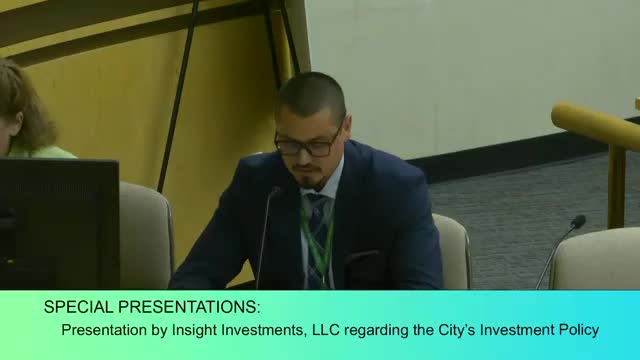Simi Valley Council Reviews Revised Investment Policy with Insight Investments Advisors
October 07, 2025 | Simi Valley, Ventura County, California
This article was created by AI summarizing key points discussed. AI makes mistakes, so for full details and context, please refer to the video of the full meeting. Please report any errors so we can fix them. Report an error »

The Simi Valley City Council meeting on October 7, 2025, featured a presentation by investment advisers from Insight Investments, who have managed the city's fixed income portfolio since 2014. The meeting aimed to review the current investment policy, assess the portfolio's performance, and discuss potential adjustments to enhance returns.
Mary Donovan, Senior Portfolio Manager at Insight, led the presentation, emphasizing that the city's investment policy complies with California state statutes and effectively meets the city's goals of safety, liquidity, and competitive returns. She reported that the portfolio has outperformed its benchmark, the 1 to 3 year Treasury index, with an annualized return of 1.92% compared to the benchmark's 1.52% over the past five years.
Donovan suggested that the city could consider extending its investment horizon from a 1 to 3 year index to a 1 to 5 year index, which could potentially yield higher returns. However, she reassured council members that the current strategy has not resulted in any financial losses, as the portfolio is structured to avoid realizing negative returns during market fluctuations.
The presentation also highlighted the importance of maintaining a diversified portfolio, with a significant allocation to corporate bonds, which can enhance returns while adhering to safety and liquidity standards. Insight Investments proposed three additional investment types that could be incorporated into the city's policy: asset-backed securities, agency mortgage-backed securities, and corporate bonds under a specific regulatory framework. While these options could provide greater flexibility and potential returns, they also introduce liquidity risks that the current portfolio does not face.
The meeting concluded with a discussion on the implications of these recommendations, emphasizing the need for careful consideration of market conditions before making any changes to the investment strategy. The council is expected to deliberate on these proposals in future meetings, aiming to optimize the management of taxpayer dollars while ensuring financial stability.
Mary Donovan, Senior Portfolio Manager at Insight, led the presentation, emphasizing that the city's investment policy complies with California state statutes and effectively meets the city's goals of safety, liquidity, and competitive returns. She reported that the portfolio has outperformed its benchmark, the 1 to 3 year Treasury index, with an annualized return of 1.92% compared to the benchmark's 1.52% over the past five years.
Donovan suggested that the city could consider extending its investment horizon from a 1 to 3 year index to a 1 to 5 year index, which could potentially yield higher returns. However, she reassured council members that the current strategy has not resulted in any financial losses, as the portfolio is structured to avoid realizing negative returns during market fluctuations.
The presentation also highlighted the importance of maintaining a diversified portfolio, with a significant allocation to corporate bonds, which can enhance returns while adhering to safety and liquidity standards. Insight Investments proposed three additional investment types that could be incorporated into the city's policy: asset-backed securities, agency mortgage-backed securities, and corporate bonds under a specific regulatory framework. While these options could provide greater flexibility and potential returns, they also introduce liquidity risks that the current portfolio does not face.
The meeting concluded with a discussion on the implications of these recommendations, emphasizing the need for careful consideration of market conditions before making any changes to the investment strategy. The council is expected to deliberate on these proposals in future meetings, aiming to optimize the management of taxpayer dollars while ensuring financial stability.
View full meeting
This article is based on a recent meeting—watch the full video and explore the complete transcript for deeper insights into the discussion.
View full meeting
